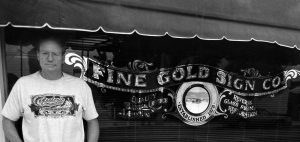In the world of artisanal glasswork, few techniques capture the imagination and skill quite like glue chipping. With its origins shrouded in history and its allure enduring through the ages, glue-chipping glass stands as a testament to the ingenuity and artistry of craftsmen throughout the centuries.

An Example Of A Glue Chipped Caffe Sign I Did Some Time Ago.
Unravelling the Origins
I first discovered Glue Chipped glass while on holiday at Disneyland in Anaheim, California, around 1990, but the roots of glue-chipping glass can be traced back to the late 19th century, a time when craftsmanship and innovation intersected in the realm of decorative glasswork. Originally developed as a method to create intricate patterns and textures on glass surfaces, glue chipping emerged as a favoured technique among artisans seeking to elevate their creations beyond the ordinary.
The Craftsmanship Behind Glue Chipping
At its core, glue chipping is a process that involves applying layers of animal hide glue to the surface of the glass, allowing it to dry and form a bond with the glass. Once the glue has set, it is carefully heated, causing it to contract and pull away, leaving behind a delicate, crystalline pattern reminiscent of frosted ferns or snail shell like patterns.
The artistry of glue chipping lies not only in its technical execution but also in the creativity and vision of the craftsman. Each piece of chipped glass is unique, bearing the imprint of the artist’s hand and the serendipitous interplay of heat and adhesive with the glass.
The Rawson & Evans Legacy
Founded in the late 1800s, Rawson & Evans quickly distinguished themselves as innovators in the realm of glass production. With a keen eye for quality and a commitment to excellence, they set out to explore new frontiers in decorative glasswork, ultimately revolutionising the industry with their groundbreaking techniques. In fact, their processes and techniques were so specialised they actually held registered patents over them.
Examples of their beautiful work can be seen here.


Evolution and Innovation
Over the decades, glue chipping has evolved alongside advancements in technology and materials. While traditional animal hide glue remains a staple in many workshops, modern alternatives have emerged, offering greater flexibility and durability without compromising the integrity of the finished product.
Innovations in heating techniques, such as the use of precision-controlled ovens, desiccants and heat guns, have also streamlined the glue-chipping process, allowing craftsmen to achieve greater precision and consistency in their work.
An Example Of The Glue Chipping Process In Progress
This video shows the way the glue chips the glass as it dries and contracts while staying bonded to the glass.
You can see the chards of glue as they release, taking a thin surface layer of glass with it, leaving a chipped surface.
Glue Chipping Glass: A Contemporary Renaissance
In recent years, glue chipping glass has experienced a renaissance of sorts as artisans and designers rediscover the timeless appeal of this age-old technique. From ornate architectural installations to delicate tabletop accents, glue-chipped glass finds expression in a myriad of forms, each imbued with its own unique charm and character.
Preserving a Time-Honored Tradition
As we look to the future, it is imperative that we continue to honor and preserve the tradition of glue chipping glass, ensuring that this venerable craft endures for generations to come. Through education, innovation, and a steadfast commitment to excellence, we can ensure that the artistry and craftsmanship of glue chipping glass continue to captivate and inspire audiences around the world.
In conclusion, the history of glue chipping glass is a testament to the enduring power of human creativity and ingenuity. From its humble origins to its contemporary renaissance, glue chipping remains a cherished tradition that continues to enchant and inspire craftsmen and enthusiasts alike. As we continue to explore the boundless possibilities of this age-old technique, let us never forget the rich tapestry of history from which it emerged, and the timeless beauty it embodies.
Your Chance To Learn & Experience This Time Honoured Craft For Yourself
I have been honing and developing my unique Glue Chipping processes since the early 1990’s, working with masters of this fine craft, such Rick Glawson I have developed a process that delivers the most beautiful, unique Glue Chipped glass pieces.
Click here to learn more about how you, too, can master this beautiful Craft yourself.
You Can Learn This, Too
My New Online Course On Mastering The Art Of Glue Chipping will take you step by step through the process, and it Is Coming Very Soon.









Jerry Padot
Thank you, I have wondered about the origins of glue chipping.
Johann Klaassen
Thank you for sending me your emails! I just discovered your blogs, and I am reading them like dessert for my brain! My father was the go-to sign guy in Washington D.C. for gold leaf for years. Unfortunately, I was raised in Iowa and due to his alcoholism and divorce I missed out on learning his trade. I took two years of Calligraphy classes at the University of Iowa. Your on-line course sounds great! Providing my finances are good, I look forward to being one of your students. Currently I am dealing with some serious health issues which are digging into my finances, so maybe I’ll have to wait on your school a bit.
Vince Edmunds
I had no idea that glue chipping had existed for so long. I was under the impression that it had been devised recently as a safer way of etching the glass without using harmful chemicals. I am looking forward to exploring this class as I have two pieces of artwork in mind that I would use this technique on.
Michael Mayer
Hallo David, i found a design drawing of one of the first blasting machines from around 1879, the Wheelabrator. It was a fast turning wheel similar to a millwheel that throws the sand on to the glass with centrifugal force.
https://www.wheelabratorgroup.com/-/media/images/wheelabrator/innovation-and-technology/history/wheel-brochure-image.jpg
Thanks for always sharing your great skills!
Regards, Michael